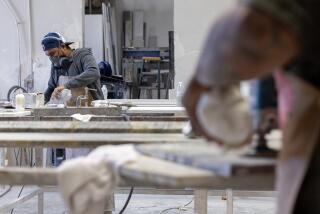Laying Job Fears to Rest : Mortuary School Students See a Bright Future: Even in Recession, They’re Assured of Employment
- Share via
CYPRESS — Bob Ingouf and the 86 other students in his department at Cypress College are up to their elbows in death--real, human death.
Before the school year is out, each of them will embalm 25 to 30 bodies. Each will practice restoring mutilated faces, study the marketing of coffins and headstones and learn the psychology of grief and the laws for funeral directors.
“People ask you, ‘How can you do that?’ ” said Ingouf.
They ask only because they, not morticians, have the death hang-ups, said Douglas G. Metz, director of the mortuary science department at Cypress College, the only public school in California that trains morticians.
“Joe Public--you and everybody else--you don’t want to die, right? People kind of shun or stay away or avoid even the idea of death,” Metz said.
“It’s not the image of us, it’s just death they don’t want to deal with. Deep inside, they don’t even want to talk about it.”
But they’re certainly willing to joke about it, even at the department’s doorstep. Asked the directions to mortuary science, one dental student pointed, then advised, “When you’re in there, be sure to keep moving.”
The mortuary students may have the last laugh, however. In the midst of a recession, they are assured of jobs when they complete their courses. Starting pay averages around $25,000 a year--less in the countryside but more in the city. Six-figure incomes await those who can build up a string of successful mortuaries.
“Nationally, there are more openings than graduates,” said Gordon S. Bigelow, executive director of the American Board of Funeral Service Education, the organization that accredits the nation’s 40 mortuary schools, most located east of the Mississippi.
“I don’t want to be crass about it, but in a recession people don’t stop dying. The funeral industry is known as a depression-proof industry. Nationally we’re graduating 1,600 a year, and that’s only marginally adequate for the demand.”
“I never in my wildest dreams thought I’d be doing something like this,” said Ingouf, who was in the restorative arts lab, where students practice using wax and makeup to hide missing or damaged parts of faces and hands. Sometimes an entire face must be sculpted from a photograph.
Death is not new to him. He has been both a cop and a driver for the county coroner, hauling bodies wherever they had to go. “It got in my blood, I guess,” he said.
Now at age 45, Ingouf has worked 3 1/2 years as an apprentice embalmer and commutes from Fullerton to Cypress to study for his own embalming certificate.
The attraction? “It’s seeing all the aspects of what you can do with a body,” he said. “Someone tells you, ‘Dad looks better now than he did 20 years ago.’ That feels good.”
David Ortiz, 23, from Las Cruces, N.M., was using Ingouf’s face for practice, applying wax to form furrows on his brow. “I’m most concerned with getting a good living and supporting my family,” he said. “This job will always be around.”
“I used to do hair and makeup on live people,” said Victor Mesce, 34, of Laguna Beach, who also was acting as a makeup mannequin.
“I always wanted to get into this business since I was 13, when my grandfather passed away. I went to the funeral home. He’d suffered, but when I saw him laid out, he looked so good. Not good, but at peace. It mesmerized me.”
Mesce was holding still while his partner smoothed makeup onto his wax-augmented nose and chin. Later he would have to stroll around campus to test whether passersby would notice the fakery.
“See,” he said, holding up a tackle-box full of the thick, opaque cosmetics, “this is the Tammy Faye Bakker deluxe kit.”
The wisecrack was part of the kidding atmosphere in the lab, with its otherwise stark displays of mangled faces and heads made whole. The professor, Robert T. Boettger, said a little jocularity is a good teaching aid. When Mesce’s partner asked how the wax, not designed to cope with body heat, could be made less sticky on Mesce’s face, Boettger replied, “Well, you could kill him.”
“We become a family unit,” Boettger said. “This is not like the normal college curriculum where you go Tuesday and Thursday and don’t see those people other than then.”
Mortuary students arrive at 8 or 9 a.m. at the tiny department rooms in a corner of the health sciences building and attend classes straight through midafternoon. They take no classes outside the department.
Forty-five students enter the program every January and August, and they complete the equivalent of three semesters in one year, attending classes during the Christmas break and summer.
Their average age is 26, but some are as young as 17 or as old as 63. About 40% are women.
“A lot are in their 40s and 50s--second-career people,” Metz said. Many are burned-out teachers trying something new. “Next semester, we’re getting a priest.”
Asked what attracts students to the profession, Metz conceded he can only guess. Boettger said people probably enter the business “by accident.”
But a University of Minnesota survey found a common thread among its mortuary students, according to Bigelow. While few had worked in the funeral business before enrolling, more than 95% had had significant personal contact with a funeral director.
“It could be anything from mowing his lawn to knowing him in church,” Bigelow said. “It appears that recruiting for the industry is a grass-roots phenomenon.
“It seems obvious that until people talk about the funeral business with someone in the business, they retain the myths about it. All they focus on is dead bodies; it’s all they think about. Yet over 95% of a funeral director’s effort is spent with the living.”
About half of Cypress College’s mortuary students come from outside California, attracted by the Southern California environment, the school’s reputation and the fact that California’s community colleges, unlike those in other states, have open enrollment. No entrance exams are required.
And while out-of-state students must pay $104 per unit, California residents pay only $50 tuition per semester. The only other mortuary school in California, the privately owned San Francisco College of Mortuary Science, charges $6,300 for a year’s tuition.
The Cypress College program was once privately owned as the Los Angeles College of Anatomy, Embalming and Sanitation, founded shortly after the turn of the century. Just before World War II, it was sold to one of its instructors, the late Melvin D. Hilgenfeld, son of an Anaheim mortician.
Almost immediately, operating the school became a struggle, said Hilgenfeld’s wife, Alma-Ruth Hilgenfeld. “The war came on, and at one time we only had seven students,” she said.
She and her husband taught classes, then swept floors at night. “We got our loans paid back, but there was only a little while when there was any profit at all. We could not pay the price for teachers we needed to have, and we couldn’t raise tuition to raise more money.”
In 1966 when his father died, Melvin Hilgenfeld shifted his attention to the family mortuary and began thinking of disposing of the school. He had been elected a trustee of the North Orange County Community College District when it was created in 1964 and remained on the board for 10 years. Why not donate the school to the district’s new campus, Cypress College?
In 1977, the new Mortuary Sciences Department opened at Cypress College, using Hilgenfeld’s donated equipment and some of the old school’s instructors.
The ties to the old school remain strong. Hanging in the department’s lobby are portraits of Hilgenfeld and Elizabeth “Ma” Green, one of the school’s earliest teachers in Los Angeles. Nearby plaques list winners of the Hilgenfeld Award (for top student in funeral directing) and the Ma Green Award (for best in restorative art). The Hilgenfeld Foundation, controlled by the Hilgenfeld family, provides the school with grants for outside speakers, seminars and special equipment, such as computer programs.
In recent years, enrollment has been relatively constant, the numbers of applicants matching the openings available, Metz said. But there are changes afoot in the California funeral industry that could affect the school’s future.
Most states require funeral directors and embalmers to have much more education than does California. Ohio demands four years of college, but in California, “if you want to be a funeral director, you don’t need anything. And to buy a mortuary, if you’re 18 and can read, you got it,” Boettger said. “The building is licensed, the business is licensed, but not the individual.”
Only Colorado has lower standards; it has no funeral regulations.
Under California state law, funeral directors are not licensed, and embalmers need only a high school education and two years of apprenticeship. The California Funeral Directors Assn., reacting to pressure from Bigelow’s national organization, has lobbied two bills into the hopper that would bring California standards closer to the national norm.
One Senate bill would require embalmers to have a two-year associate’s degree and continue their education after graduation.
An Assembly bill would require “arrangement counselors”--the person dealing directly with survivors--to be 18 years old, have a high-school education and pass a test on funeral law, grief-related psychology and funeral customs. A spokesman for the funeral association likened the test to a driver license exam; the state would publish a booklet containing all information necessary to pass.
“The whole idea of licensing this group is that right now if they do anything wrong, there’s nothing you can do. You can fire them, but they just go somewhere else. With licensing, the state has the authority to discipline them,” said George Prather, a Sacramento mortician leading the lobbying effort.
Both bills have passed through initial committee hearings, and neither has provoked overt opposition.
“By raising standards, the whole industry will encounter fewer problems,” said Prather. “You just get a more serious person, someone who’s going to stay around. It’s preventive maintenance.”
Prather concedes that some in the industry fear higher educational standards will shrink the labor pool. “But we’ve found out that sometimes it increases it,” Prather said. In Maryland, for example, tougher educational requirements were passed in 1988, and mortuary school enrollment immediately fell 27%. But the number of graduates increased 25%.
“The dropout rate fell,” Prather said. “Potential dropouts just weren’t bothering to enroll. You wound up with more serious people.”
Enrollment is likely to increase in any case, Metz said. The huge baby-boom generation, which has bloated every aspect of society through which it has passed, now is pushing 50 years old. After the end of the century, the least healthy of them will start dying, signaling the beginning of a funeral industry boom.
“We’re needing people in the field,” Metz said. “The unique thing about this industry is we can gloat a little that it’s the oldest--or one of the oldest--professions in the world. Since prehistoric man, we’ve been taking care of our dead.
“You may not make $100,000 a year, but there will always be work.”
More to Read
Sign up for Essential California
The most important California stories and recommendations in your inbox every morning.
You may occasionally receive promotional content from the Los Angeles Times.













